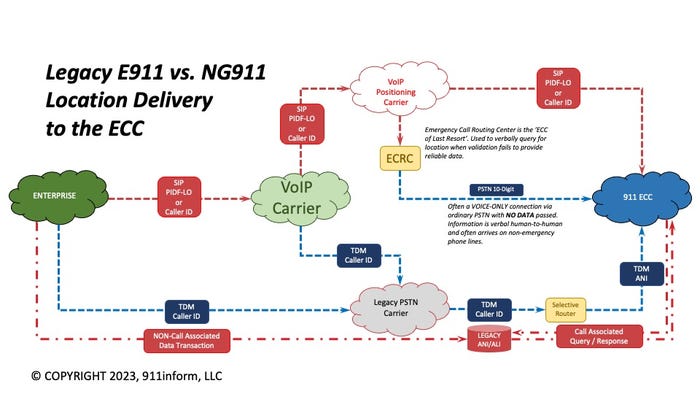911 Is Getting a Lot Smarter. Here Are Several Things You Need to Know911 Is Getting a Lot Smarter. Here Are Several Things You Need to Know
For one thing, there's no such thing as a national 911 center

E911 as we know it will slowly fade into the sunset, and as Next Generation 911 becomes the standard, the key technology has evolved as well, with aging ANI/ALI (Automatic Number Identification/Automatic Location Information) databases replaced by underlying Presence Information Data Format Location Object (PIDF-LO)-driven formats used to deliver accurate location information when a call to 911 is made. In as good a definition as we’ve seen, the communications platform company Bandwidth defines PIDF-LO as "an HTTP, XML tag format that includes a location object. PIDF-LO takes those location objects and embeds them natively with the 911 call across the Internet, allowing for instant provisioning with hyper-targeted accuracy, [particularly] as a caller moves about a campus or high-rise environment."
As this ANI/ALI-to- PIDF-LO evolution is occurring, there is one other acronym evolution as well, with the well-worn PSAP (public safety answering point) name being replaced by ECC (emergency communications center).
Recently, a colleague raised an interesting question in which he referred to a national 911 center. This caught our attention, because, for starters, there is no such thing. Secondly, his question suggested that there may be a belief out there that such a single national center does exist, even though it does not.
What Differentiates E911 from Next Gen 911?
Next Gen 911 provides a new way of conveying location information. The Location Object (the LO from PIDF-LO) provided via SIP will carry the relevant data from the origination network to the terminating ECC. The primary concern currently is how to verify the validity of the data that’s contained within the outgoing SIP message. Historically, E911 relied on information stored in static ANI/ALI databases which were often housed in old central office telephone switches which are being phased—or aged—out of operation. The short, non-technical answer is that the information that can be provided to the ECC at the time of the call can now be more current. This is not a guarantee, but it’s a step in the right direction.
Given that a truly complete and current national database does not exist, how can accurate location information be provided? Or, better said, “is accurate location information provided nationwide?” The answer is that accurate location information can be provided in many, if not most, situations—but not necessarily all.
What the Law Requires
By law, voice over IP (VOIP) providers interconnecting to the PSTN must “transmit all 911 calls, as well as ANI (automatic number identification) and the caller’s Registered Location for each call, to the PSAP, designated statewide default answering point, or appropriate local emergency authority that serves the caller’s Register.”
However, the “Registered Location” and the actual location may not be the same, thus creating another significant challenge. Since late 2005 (yes, you read that correctly), VOIP providers have been required to obtain from customers the physical location at which the service will first be used, and secondly, provide end users with “one or more methods for updating their Registered Location.”
In addition, and most critically, the law states that each interconnected VoIP service provider shall advise every subscriber, both new and existing, prominently and in plain language, of the circumstances under which E911 service may not be available through the interconnected VOIP service or may be in some way limited in comparison to traditional E911 service, and they shall also get and keep their customers' affirmative acknowledgments of this advisory, and they shall warn existing and new subscribers by "conspicuous means" if E911 service may be limited or not available.
On the other end of the 911 call, the provider of dialtone has an obligation to provide access to the PSAP/ECC. Each state mandates this connection, although it may not specify the precise means for delivering it. The state is not in the phone business, so it contracts with entities that are. In most cases, states contract with existing providers or other companies to make this connection real, and often these contracts are awarded regionally. However, it’s possible—and often likely—that there will be multiple “hops” between a local service provider and the PSAP/ECC. This is not necessarily a bad thing, but it does create more potential points of failure.
However, the biggest issue is that whoever is managing the location information can only operate with the best information that it receives. Keeping these PSAP/ECC databases current is a monumental and ongoing task and not without significant risk, particularly with current dynamic and nomadic conditions that essentially define phone usage today.
Takeaways:
While ANI and ALI may be going the way of the dodo bird, the information provided via PIDF-LO makes location identification an easier, if not flawless process.
If your enterprise is relying on VOIP, make sure that your end users, including guests and contractors, as well as work from home employees, are aware of system limitations
As in many technology applications to real life situations, the technology has far-surpassed the regulation that was designed to manage it. As such, the best advice is to know the law and listen to vendor guidance with at least one grain of salt.
Caution should be exercised. This is not a simple configuration task that is solved by following steps A to Z. It requires thought and planning and an understanding of the E911 environment today, the new NG911 environment, and the legal requirements. (And nothing in this article should be construed as offering legal advice.). Knowledge of future trends is essential, tempered with reality and end-of-lifecycles of hardware. But then again, this is a critical life safety issue, that could not only delay emergency services, but expose the enterprise to a potentially huge liability.

Legacy E911 architectures feed location data updates as a separate, non-associated transaction that occurs separately from a 911 call. Database records available to the ECC can become ‘stale’ due to an inherent 24 to 48-hour delay in the update process. NG911 calls, on the other hand, include real-time location snapshots of information acquired at the time of the call. This current, and presumably more accurate, location is included in the SIP header as a PIDF-LO location object, providing the most current information collected from the originating network.
About the Authors
You May Also Like







